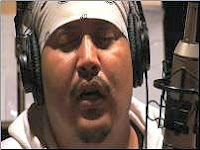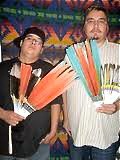Peyote songs are the prayer music and ceremonial heart of the Native American Church. The songs have traditionally been sung, accompanied by the gourd rattle and water drum, in the various languages and musical styles of the indigenous peoples from which the church drew its membership.
At the same time, the pan-Indian nature of the church made it a powerful vehicle for the diffusion of musical styles and content. Early studies of peyote songs, dating from the 1940s, found Navajo peyote singers using the Ute musical style, and recognizably the same peyote song among the Tarahumara, Navajo, and Cheyenne. Such studies can be helpful in tracing the historical spread of the new religious movement.
An important aspect of peyote songs is their use of non-lexical vocables — sequences of phonemes without conventional semantic content, but meaningful to the singer in the context of the ceremony, and often an indication of the song’s origin as a spiritual gift. Peyote songs often combine the consonants y, w, h, c, k, t, x, and n with vowels, in the sequence CVCVCV… to produce vocables such as the important peyote word heyowicinayo.
Beginning in the 1990s — their first CD was released in 1995 — two singers, Verdell Primeaux, a Sioux, and Johnny Mike, a Navajo, developed a new form of peyote music they called healing songs, characterized by mesmeric and meditative vocal harmonies and frequently without the paradigmatic driving beat of the water drum and gourd rattle.
 |
| Brian Stoner |
Their haunting music, however, embodied a partial disconnection from the traditional roots of the peyote song, where the gourd rattle and water drum have traditionally been an integral part of the ceremony, and tying the soaked deerskin drumhead onto the cast-iron drum kettle is an important and symbolically resonant part of the preparation. Indeed, this disconnection in part drove their popularity. One music reviewer — apparently intending to be complimentary — went so far as to say that the new peyote music “transcends the usual ethnographic feel of peyote recordings and becomes true art.”
 |
| Whitehorse and Crowe |
Three of these singers are Brian Stoner, from the Ponca and Cherokee tribes of Oklahoma; and the brothers Maynard Whitehawk and Lance Crowe, of Plains Anishinabe and Saulteaux heritage, who sing together under the name Wikiwam Ahsin, which are Anishinabe words usually translated as tipi rock. I have attached two representative videos below.
The first video features a song set from the album With Love and Faith We Pray, which was named the Best Spiritual Album at the 2007 Indian Summer Music Festival, and which features Whitehawk and Crowe joining Stoner on several songs. The second features a set from Whitehawk and Crowe’s eponymous album Wikiwam Ahsin. Listen for the children’s songs at the end.

- Previous Post: Dealing with Snakebite II
- Next Post: Hyperthermia
- More Articles Related to: Books and Art, Indigenous Culture, Sacred Plants, The Medicine Path



dear Steve,
i find myself having to respond yet again. my wife and i are sitting out our kitchen table, looking out over several hundred acres of wood and pasture…drinking a hot cup of chai on a windy and rainy day in Oregon…and listening…inspired by drums, voices, rhythms of the Peyote Songs. for young born old, and old born young again; and yet again. and it brings such joy to our hearts to hear the old music of this Turtle Island, sung so soulfully by a new generation of young bloods.
yesterday we had a huge bald eagle land in our lower pasture. first ever in this area. thank you for pointing your fine compass into such rich and soulful territory…
David
I envy you your chai and eagle. Thank you for browsing in the blog and leaving your inspiring comments.
Steve’s way
Heyo wa ne he yana
he ne
heyo wa ne he ya na he
yo we
Steve’s way
heyo wa ne he he ya
heya na hende yo we…
Can you please help me understand the meaning of
He yana he ne yo we? Thank you so much.
Thank you for making me smile. Allow me to make a public recommendation of your dating services.
Aho! from Canada
Welcome to the blog! Please wander around, leave comments, and subscribe if you wish. I am always happy to hear from a country that is colder than Chicago. :-)
I went on over to your blog, enjoyed the beautiful pictures, and was greeted by Walela. What a treat!
hi im full blooded navajo i love the peoty music
Thank you for the beautiful prayers.
This is great! I’m doing a paper on Jesse Ed Davis and when he sings Leon Russell’s song “Alcatraz” about the American Indian occupation from 1969 to ’71, he adds a refrain of, “Heya a heyo!” Does this have a special meaning? I’d like to get it right. Thanks!
Hearing these beautiful songs fills my eyes with tears, in a good way. Thank you younger brothers for your healing prayers. Yesterday I was asked to pray for a 90 year old Lakota grandmother who went out to protest the pipeline through Lakota lands and is now missing. Could I ask you to tie drum and send healing for this family ? You are wonderful singers; big medicine. Thank you.
I am from Brasil, and I want to learn sing some peyote songs, but it is very difficult to me understand what is singing…
there is some site were is possible to find written lirycs?
excuse me about my english
thank froom Brasil
Hello dear friends ! where can i find peyote songs with lyrics ? i want to thank the fire next time by singing to our “grandfather” ! love and respect to all
Steve, I came up with the old men from Taos pueblo in the 1960s, Little Joe & John Gomez, Tellus Goodmorning & Frank Zamora, & others. I learned the most important lessons about singing & expressing myself from them. I learned respect. I learned how to pray. There was a real connection made here between these old men & the hippies. Back then we wanted to know about & understand these experience we were having, these psychedelic experiences, & the old men were the only ones who truly possessed that knowledge. Everyone else (Leary, Watts, etc) was merely speculating.
(continuing) What I wanted to comment on, on the subject of peyote music, songs, was the change brought about by singers from Mexico. In california & Texas I recently heard Mechica songs, often in spanish, often referencing Tonatzin. A friend of mine in a movie made in Germany with Dennis Hopper, The American Friend, is shot & dying in the gutter in Berlin & the last word from his dying lips – Hey Ney Yo Way. I dont think many people got it, but we did in Taos.
I drum to this music along with Louie Gonnie’s group. It is very helpful.